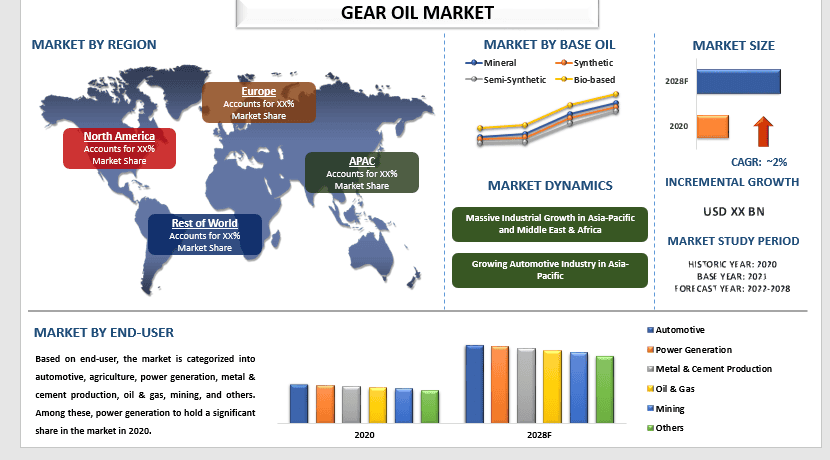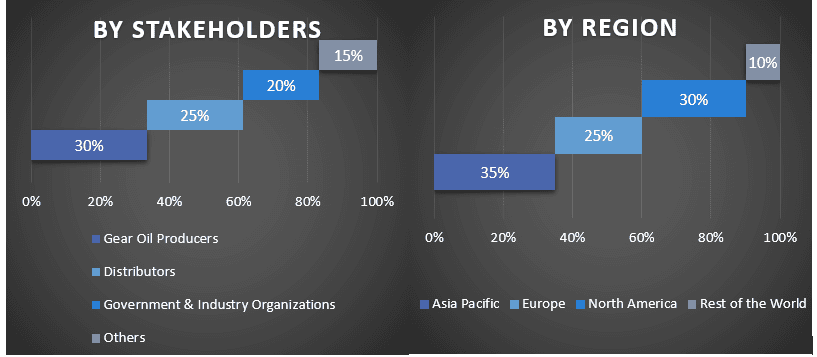- Home
- About Us
- Industry
- Services
- Reading
- Contact Us
Gear Oil Market: Current Analysis and Forecast (2022-2028)
Emphasis on Base Oil (Mineral Oil, Synthetic Oil, Semi-Synthetic Oil, and Bio-Based Oil); End-User (Automotive, Agriculture, Power Generation, Metal & Cement Production, Oil & Gas, Mining, and Others); and Region/Country

Global Gear Oil Market is expected to grow at a significant rate of around 2% during the forecast period. A Gear Oil is a lubricant specially designed for transmission, transfer case, and differential in automobiles, trucks, and other machinery. In recent years, the demand for gear oil has risen dramatically due to the rising growth in the automobile and industrial sector as well as the growing demand for the power industry. As gear oil is used to enhance the operation of the transmission system and to loosen wear and tear while offering better fuel economy. The demand for better fuel economy and power industry demand is significantly fulfilled by higher quality gear oil coupled with rising technological advancements to provide a better quality of gear are going to create lucrative opportunities for market growth of gear oil globally. For instance, In April 2022, Tata Motors announced plans to invest around USD 3.1 billion (INR 24,000 crores) in its passenger vehicle business over the next five years.
Shell plc, Exxon Mobil Corporation, Chevron Corporation, TOTAL S.A., Valvoline LLC, BP plc, FUCHS, Idemitsu Kosan Co. Ltd., PetroChina Company Limited, Sinopec Group are some of the key players in the market. Several M&As along with partnerships have been undertaken by these players to facilitate customers with hi-tech and innovative products/technologies. For instance, In September 2021, the construction of a new fishing training ship that complies with international standards began in Taiwan and is expected to be completed in 2023. The government of Taiwan invested US$ 30.2 million (NT$ 840 million) for its construction which will drive the market growth of gear oil in Taiwan.
Insights Presented in the Report
“Amongst base oil, mineral oil category to witness higher CAGR during the forecast period”
Based on base oil, the market is segmented into mineral oil, synthetic oil, semi-synthetic oil, and bio-based oil. The mineral oil category is to witness higher CAGR during the forecast period owing to its various applications such as air compressors, airline oilers, bearings, blowers, circulating systems, cranes, gearboxes, and hydraulics, industrial turbines, and vacuum pumps. Mineral Oil is being adopted to offer superior performance by reducing friction and power loss as well as managing temperature rise in the gearboxes. Furthermore, the entry of global players into emerging markets adds to the growth of the market of gear oil.
“Amongst end-user, power generation to hold a significant share in the market in 2020”
Based on end-user, the market is categorized into automotive, agriculture, power generation, metal & cement production, oil & gas, mining, and others. Among these, power generation to hold a significant share in the market in 2020. This is mainly due to the rapid growth in the increasing installed capacities of wind turbines every year. As gear oils have application in wind turbines for lubrication of the main gearbox and other gear motor components. For instance, India is likely to attract a huge investment of USD 145.5 billion (INR 1,155,652 crore) into the power generation sector by 2022, for setting up projects across the thermal, hydro, nuclear, and renewables segments which will drive the market growth of gear oil.
“Asia-Pacific to hold a significant share in the market”
In 2020, Asia-Pacific is anticipated to grow at a substantial CAGR during the forecast period. This is mainly due to the increasing industrial production, construction, and transportation activities taking place in developing countries such as India, and China. According to the World Steel Association, China is the world leader in crude steel production. For instance, in 2020, China’s crude steel production was 1,064.8 million tons, up about 7% from 2019. In addition, in September 2021, Airbus and Tata Aircraft entered a partnership to build aircraft in India. Also, the development of new chemical industry plants in South Korea will benefit the growth of the country’s chemical industry. For instance, in 2021, construction began on the Posco lithium hydroxide plant in South Korea to end by 2023. Furthermore, the consumption of power generation or electricity is increasing on daily basis in various regions. In September 2020, the expansion work of the gas power generation plant started for the Datan Power Plant in Taiwan will be completed by 2024. Therefore, the surging industrial sectors which include wind power, oil & gas, chemical, mining, steel, transportation, construction, and more are accelerating the gear oils market growth in the Asia-Pacific region.
Reasons to buy this report:
- The study includes market sizing and forecasting analysis validated by authenticated key industry experts.
- The report presents a quick review of overall industry performance at one glance.
- The report covers an in-depth analysis of prominent industry peers with a primary focus on key business financials, product portfolio, expansion strategies, and recent developments.
- Detailed examination of drivers, restraints, key trends, and opportunities prevailing in the industry.
- The study comprehensively covers the market across different segments.
- Deep dive regional level analysis of the industry.
Customization Options:
The global gear oil market can further be customized as per the requirement or any other market segment. Besides this, UMI understands that you may have your own business needs, hence feel free to connect with us to get a report that completely suits your requirements.
Table of Content
Research Methodology for the Gear Oil Market Analysis (2022-2028)
Analyzing the historical market, estimating the current market, and forecasting the future market of the global gear oil market were the three major steps undertaken to create and analyze the adoption of gear oil in major regions globally. Exhaustive secondary research was conducted to collect the historical market numbers and estimate the current market size. Secondly, to validate these insights, numerous findings and assumptions were taken into consideration. Moreover, exhaustive primary interviews were also conducted, with industry experts across the value chain of the global gear oil market. Post assumption and validation of market numbers through primary interviews, we employed a top-down/bottom-up approach to forecasting the complete market size. Thereafter, market breakdown and data triangulation methods were adopted to estimate and analyze the market size of segments and sub-segments of the industry pertains to. Detailed methodology is explained below:
Analysis of Historical Market Size
Step 1: In-Depth Study of Secondary Sources:
Detail secondary study was conducted to obtain the historical market size of the gear oil market through company internal sources such as annual reports & financial statements, performance presentations, press releases, etc., and external sources including journals, news & articles, government publications, competitor publications, sector reports, third-party database, and other credible publications.
Step 2: Market Segmentation:
After obtaining the historical market size of the gear oil market, we conducted a detailed secondary analysis to gather historical market insights and share for different segments & sub-segments for major regions. Major segments are included in the report as base oil and end-user. Further country-level analyses were conducted to evaluate the overall adoption of testing models in that region.
Step 3: Factor Analysis:
After acquiring the historical market size of different segments and sub-segments, we conducted a detailed factor analysis to estimate the current market size of the gear oil market. Further, we conducted factor analysis using dependent and independent variables such as various base oil and end-user of gear oil. A thorough analysis was conducted for demand and supply-side scenarios considering top partnerships, mergers and acquisitions, business expansion, and product launches in the gear oil market sector across the globe.
Current Market Size Estimate & Forecast
Current Market Sizing: Based on actionable insights from the above 3 steps, we arrived at the current market size, key players in the global gear oil market, and market shares of the segments. All the required percentage shares split, and market breakdowns were determined using the above-mentioned secondary approach and were verified through primary interviews.
Estimation & Forecasting: For market estimation and forecast, weights were assigned to different factors including drivers & trends, restraints, and opportunities available for the stakeholders. After analyzing these factors, relevant forecasting techniques i.e., the top-down/bottom-up approach were applied to arrive at the market forecast for 2028 for different segments and sub-segments across the major markets globally. The research methodology adopted to estimate the market size encompasses:
- The industry’s market size, in terms of revenue (USD) and the adoption rate of the gear oil market across the major markets domestically
- All percentage shares, splits, and breakdowns of market segments and sub-segments
- Key players in the global gear oil market in terms of products offered. Also, the growth strategies adopted by these players to compete in the fast-growing market
Market Size and Share Validation
Primary Research: In-depth interviews were conducted with the Key Opinion Leaders (KOLs) including Top Level Executives (CXO/VPs, Sales Head, Marketing Head, Operational Head, Regional Head, Country Head, etc.) across major regions. Primary research findings were then summarized, and statistical analysis was performed to prove the stated hypothesis. Inputs from primary research were consolidated with secondary findings, hence turning information into actionable insights.
Split of Primary Participants in Different Regions

Market Engineering
The data triangulation technique was employed to complete the overall market estimation and to arrive at precise statistical numbers for each segment and sub-segment of the global gear oil market. Data was split into several segments & sub-segments post studying various parameters and trends in the areas of base oil and end-user in the global gear oil market.
The main objective of the Global Gear Oil Market Study
The current & future market trends of the global gear oil market were pinpointed in the study. Investors can gain strategic insights to base their discretion for investments on the qualitative and quantitative analysis performed in the study. Current and future market trends determined the overall attractiveness of the market at a regional level, providing a platform for the industrial participant to exploit the untapped market to benefit from a first-mover advantage. Other quantitative goals of the studies include:
- Analyze the current and forecast market size of the gear oil market in terms of value (USD). Also, analyze the current and forecast market size of different segments and sub-segments
- Segments in the study include areas of base oil and end-user.
- Define and analysis of the regulatory framework for the gear oil
- Analyze the value chain involved with the presence of various intermediaries, along with analyzing customer and competitor behaviors of the industry.
- Analyze the current and forecast market size of the gear oil market for the major region.
- Major countries of regions studied in the report include Asia Pacific, Europe, North America, and the Rest of the World.
- Company profiles of the gear oil market and the growth strategies adopted by the market players to sustain in the fast-growing market
- Deep dive regional level analysis of the industry
Related Reports
Customers who bought this item also bought










